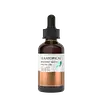What's inside
What's inside
 Key Ingredients
Key Ingredients

No key ingredients
 Benefits
Benefits

 Concerns
Concerns

No concerns
 Ingredients Side-by-side
Ingredients Side-by-side

Argania Spinosa Kernel Oil
EmollientSqualane
EmollientHelianthus Annuus Seed Oil
EmollientOpuntia Ficus-Indica Seed Oil
EmollientSclerocarya Birrea Seed Oil
HumectantCannabis Sativa Seed Oil
EmollientTerminalia Ferdinandiana Fruit Extract
AntioxidantCamellia Oleifera Seed Oil
Skin ConditioningTetradecane
PerfumingPassiflora Incarnata Flower Extract
Skin ConditioningWithania Somnifera Extract
Skin ConditioningCalendula Officinalis Flower
Skin ConditioningArnica Montana Flower
Skin ConditioningCaprylic/Capric Triglyceride
MaskingPhoenix Dactylifera Seed Extract
MoisturisingCannabis Sativa Flower/Leaf/Stem Extract
AntioxidantBakuchiol
AntimicrobialRosmarinus Officinalis Extract
AntimicrobialAroma
Argania Spinosa Kernel Oil, Squalane, Helianthus Annuus Seed Oil, Opuntia Ficus-Indica Seed Oil, Sclerocarya Birrea Seed Oil, Cannabis Sativa Seed Oil, Terminalia Ferdinandiana Fruit Extract, Camellia Oleifera Seed Oil, Tetradecane, Passiflora Incarnata Flower Extract, Withania Somnifera Extract, Calendula Officinalis Flower, Arnica Montana Flower, Caprylic/Capric Triglyceride, Phoenix Dactylifera Seed Extract, Cannabis Sativa Flower/Leaf/Stem Extract, Bakuchiol, Rosmarinus Officinalis Extract, Aroma
Ingredients Explained
These ingredients are found in both products.
Ingredients higher up in an ingredient list are typically present in a larger amount.
You may know this ingredient as argan oil. Argan Oil has antioxidant, hydrating, and soothing properties.
Studies have shown argan oil can help fight again radical damage from the sun. This makes it effective at preventing hyperpigmentation.
Large amounts of vitamin E found in argan oil helps the skin retain water. Argan oil also contains fatty acids such as linoleic acid, oleic acid, and palmitic acid. It is also a good source of lipids.
Another benefit of argan oil is skin-soothing. It can help reduce inflammation-related skin symptoms.
Argan Oil is effective at regulating sebum production in pores. This can make it effective at treating hormonal acne.
Traditionally, argan oil was used for its antibacterial and antifungal properties. However, argan oil contains fatty acids that may make it not fungal-acne safe.
Argan Trees are native to Morocco.
Learn more about Argania Spinosa Kernel OilHelianthus Annuus Seed Oil is the oil derived from the seeds of a Sunflower. Sunflower seed oil is non-fragrant. It is an emollient, meaning it helps to soften the skin.
Sunflower seed oil contains many fatty acids. The fatty acids found in sunflower seeds include (from highest amount to least): linoleic acid, myristic acid, palmitic acid, stearic acid, arachidic acid, oleic acid, and linolenic acid.
These fatty acids help the skin create ceramides. Ceramides play a role in repairing the skin barrier.
Helianthus Annuus Seed Oil helps moisturize the skin. This in turn helps the skin look more rejuvenated and smoother.
Sunflowers are rich in vitamin E.
Historians believe Indigenous cultures of North America domesticated sunflowers before corn. Thus they relied on sunflower oil for a variety of uses. One such use is moisturizing skin and hair.
Sunflower seed oil may not be fungal acne safe. We recommend speaking with a professional if you have any concerns.
Learn more about Helianthus Annuus Seed OilSclerocarya Birrea Seed Oil is the oil expressed from the seeds of the Marula plant. In South Africa, Marula is called "an elephant's favorite treat".
Marula seed oil is a non-fragrant oil. It is rich in fatty acids, such as oleic, linoleic, palmitic, stearic, and more. These fatty acids help hydrate the skin.
Other components of marula seed oil include vitamin E and antioxidants such as flavonoids.
Due to the fatty acid content, this ingredient may not be fungal-acne safe.
Learn more about Sclerocarya Birrea Seed Oil